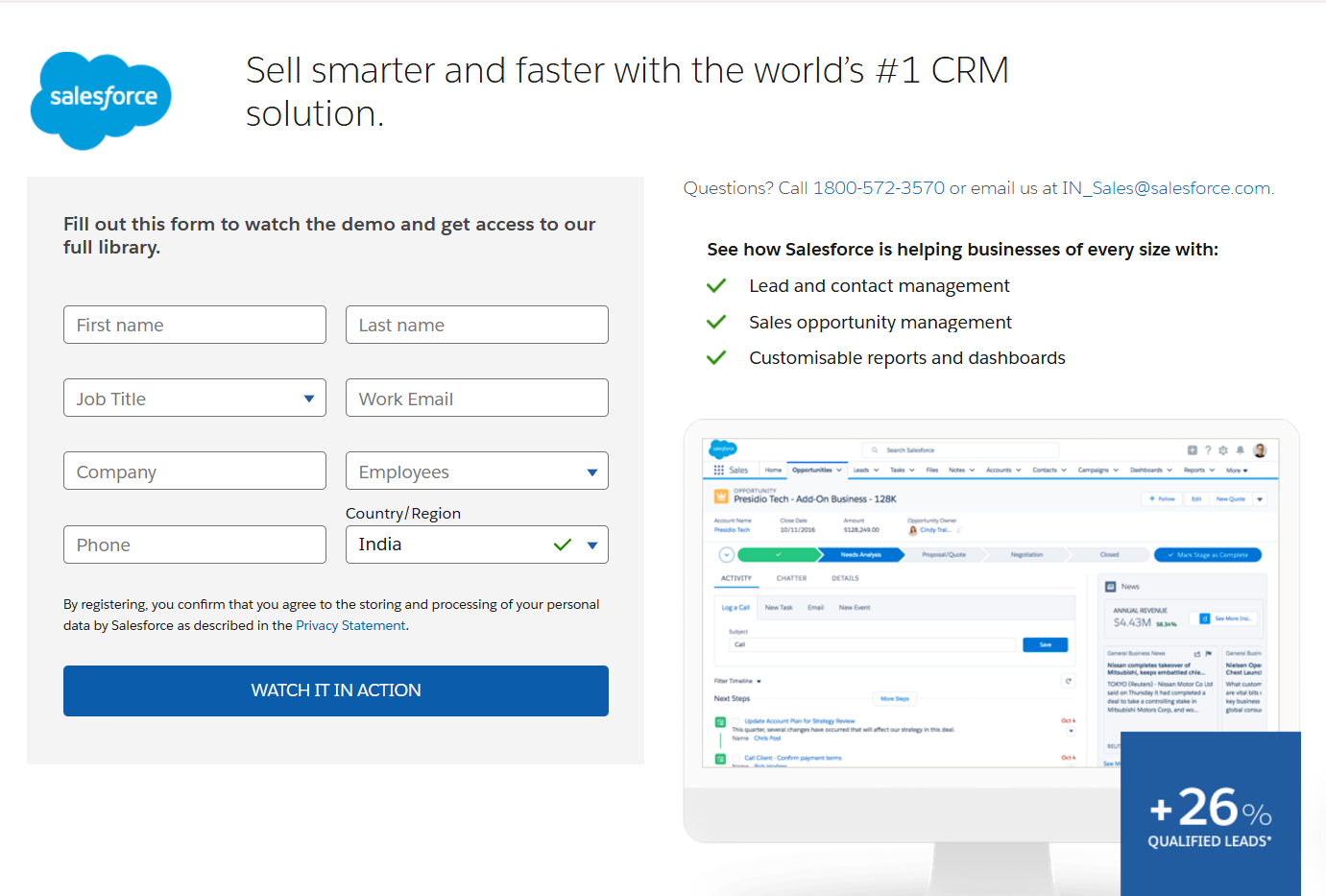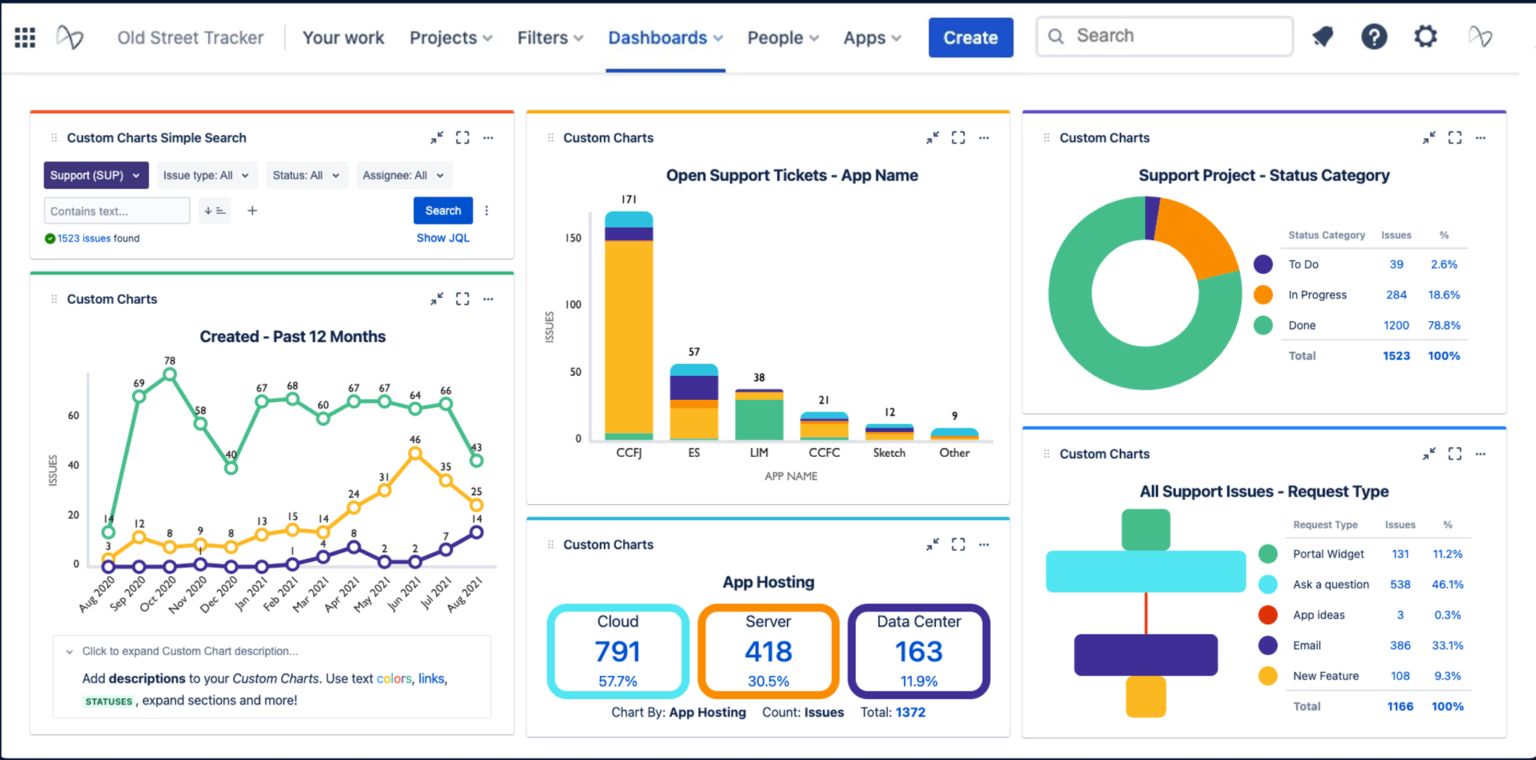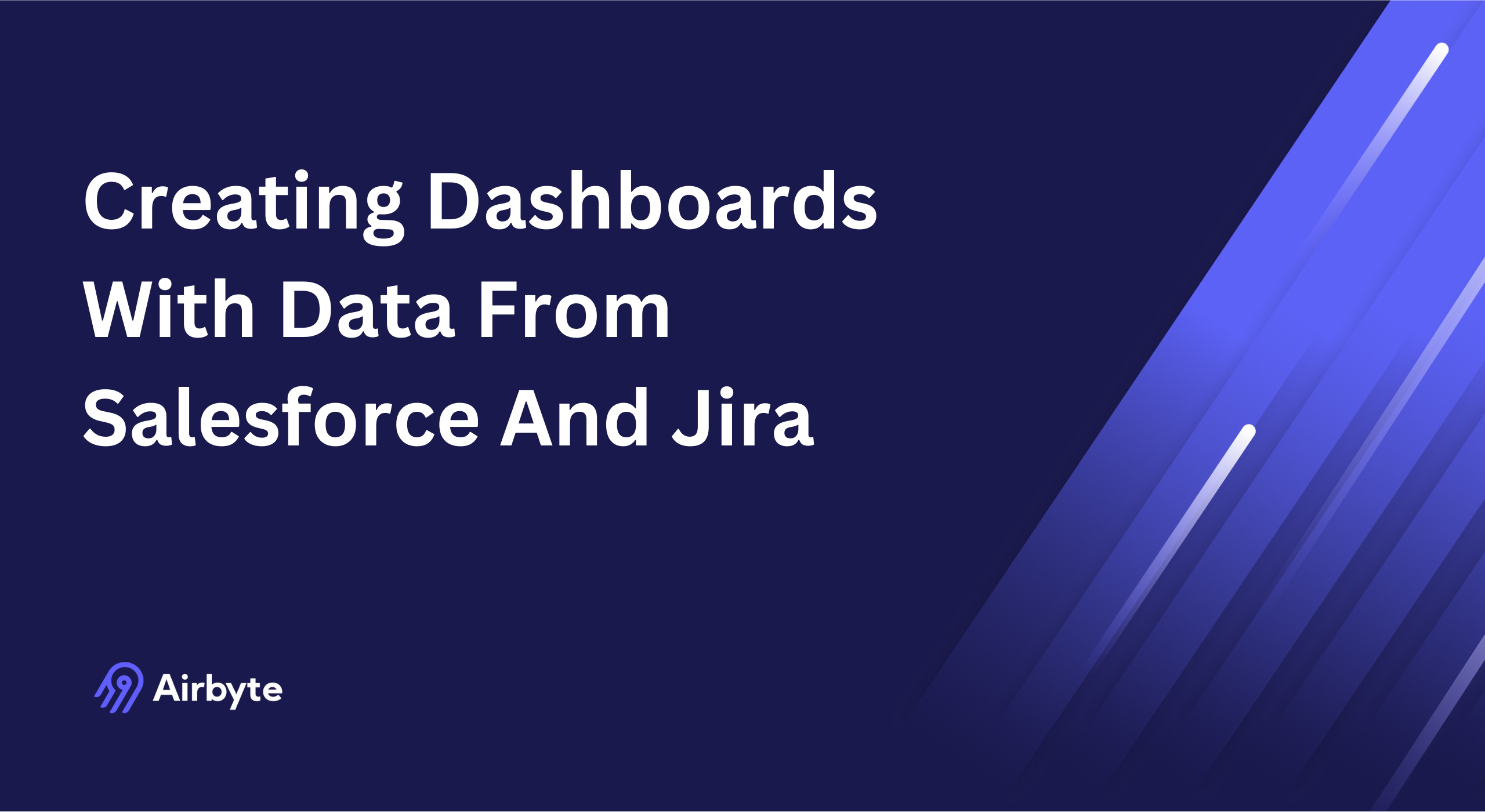How to Create Dashboards With Data From Salesforce And Jira?
Summarize this article with:
✨ AI Generated Summary
Integrating Salesforce and Jira data for dashboards often faces challenges like prolonged engineering time, complex data schemas, and governance issues, but modern tools like Airbyte and AI-powered features streamline this process. Key benefits include centralized, real-time, and customizable dashboards that unify customer insights and operational metrics, enhancing decision-making and cross-team collaboration. Practical use cases involve correlating support tickets with revenue, aligning sales pipelines with project milestones, and optimizing performance metrics for strategic advantage.
When data teams at growing enterprises attempt to create dashboard with data from Salesforce and Jira, they often discover a troubling reality: the integration process that should take weeks instead consumes months of engineering resources, while traditional ETL platforms require specialized expertise that costs organizations significant resources just to maintain basic data pipelines. This disconnect between expectation and reality isn't merely a technical challenge but a strategic bottleneck that prevents organizations from leveraging their most valuable business insights.
The challenge becomes even more acute when you consider that Salesforce controls a significant portion of the CRM market while Jira dominates project-management workflows. These platforms contain the operational DNA of modern businesses, yet most organizations struggle to unify this data effectively. Without proper integration, customer-support teams manually re-enter critical information between systems, development teams lose visibility into customer impact, and executives make decisions based on fragmented insights rather than comprehensive operational intelligence.
This article explores how to create a dashboard with data from Salesforce and Jira through modern integration approaches that eliminate traditional bottlenecks while providing enterprise-grade security and governance. You'll discover practical implementation strategies, overcome common integration challenges, and leverage emerging AI-powered features that transform disconnected tools into unified decision-making engines.
What Is Salesforce and Why Does It Matter for Dashboard Integration?

Salesforce is a cloud-based CRM platform that enables you to manage all your customer information in one place. It provides a comprehensive customer view with its Customer 360 technology, enabling you to manage sales, marketing, and campaigns more efficiently. The platform's recent updates, including enhanced Data Cloud capabilities and Einstein AI integration, have transformed it from a simple CRM into a comprehensive customer-intelligence hub that processes numerous interactions daily.
Modern Salesforce implementations extend far beyond basic contact management. The platform now includes advanced analytics capabilities, real-time customer-journey mapping, and predictive insights that help organizations anticipate customer needs before they become explicit requirements. These capabilities make Salesforce data particularly valuable for dashboard creation, as it provides both transactional customer data and behavioral insights that can inform strategic decision-making.
To establish a seamless data flow between your analytical and Salesforce ecosystem, you can use data integration tools. This integration capability becomes especially critical when combining Salesforce customer intelligence with operational data from project-management systems like Jira, creating a unified view of how customer relationships impact and are impacted by internal operations.
Key Features of Salesforce for Dashboard Integration
Sales Cloud features allow you to manage sales data and include tools for lead management, forecasting, and opportunity tracking that provide rich datasets for revenue analysis and pipeline visualization. Customer-support tools like case tracking, omnichannel routing, and self-service portals create detailed interaction histories that, when combined with Jira issue tracking, allow you to correlate customer satisfaction with product-development priorities.
Comprehensive customer profiles covering email, phone, social, and other touchpoints serve as the foundation for dashboards that connect customer behavior patterns with internal operational metrics tracked in Jira. These profiles enable you to understand the complete customer journey and how internal processes affect customer experience.
What Is Jira and How Does It Complement Salesforce Data?

Jira is project-management software developed by Atlassian that helps your teams track and manage issues within a project. It supports agile methodologies like Scrum and Kanban and provides tools for planning, collaboration, and reporting. Recent updates have enhanced Jira's dashboard capabilities with improved data-source viewing modes, though new native visualization options like percentage bar charts have not been added.
By storing different forms of data including issues, comments, and project metrics, Jira allows you to streamline collaboration while generating detailed operational insights. These insights become particularly valuable when integrated with Salesforce customer data, as they provide visibility into how internal operations and development priorities impact customer experience.
You can load the project-management data from Jira to your data store using ETL tools, then combine it with Salesforce data for comprehensive dashboards.
Key Features of Jira for Dashboard Integration
Project boards let you track task status and understand work distribution, generating workflow metrics essential for dashboards. Issue-tracking tools create detailed activity logs that, when combined with Salesforce data, help identify how operations impact customer outcomes.
Custom workflows ensure that data accurately reflects your organization's processes, which serves as a critical foundation for executive dashboards. Native integrations with Confluence, Slack, and others add collaboration metrics that further enrich dashboard insights.
What Are the Key Benefits of Creating Salesforce and Jira Dashboards?
- Centralized Data Visualization: Designing dashboards with data from Salesforce and Jira centralizes key metrics including project progress, team performance, and customer insights into one place. This centralization reduces cognitive load and enables faster decision-making across your organization.
- Real-Time Updates: Integrated dashboards reflect real-time changes in either system, allowing teams to monitor how issue resolution affects customer satisfaction. Teams can react promptly when correlated metrics shift, enabling proactive customer management and operational adjustments.
- Customization: Dashboards can be tailored by role, with AI-powered recommendations optimizing layout and metric selection. This ensures every stakeholder sees the insights most relevant to their responsibilities and decision-making needs.
What Are the Common Challenges When Integrating Salesforce and Jira Dashboards?
Technical and Architectural Complexity
Different data schemas, API rate limits, and field-mapping requirements can create compatibility issues. Exceeding API call thresholds or misaligned field mappings often results in failed syncs and inaccurate dashboards.
Organizations frequently underestimate the complexity of maintaining data consistency across platforms with different update frequencies and data structures. This complexity requires careful planning and robust error handling to ensure reliable dashboard performance.
Data Quality and Governance Issues
Bidirectional sync risks duplicates and fragmented views across your integrated systems. Inconsistent data-entry practices and complex audit requirements further complicate unified reporting and compliance efforts.
Maintaining data lineage and ensuring proper governance becomes challenging when data flows between multiple systems. Organizations must establish clear data stewardship processes to prevent quality degradation over time.
Organizational and Process Alignment
Conflicting team priorities, user-adoption resistance, and change-management hurdles can stall projects unless addressed with thoughtful stakeholder engagement. Different teams may have varying definitions of success metrics, creating confusion in dashboard design.
Successful integration requires alignment between technical implementation and business processes. Without proper change management, even technically successful integrations can fail to deliver business value due to poor adoption and inconsistent usage patterns.
How Do You Create a Dashboard with Data from Salesforce and Jira Using Airbyte and Python?

Airbyte is an open-source data-integration platform with 600+ connectors. Its Python SDK, PyAirbyte, lets you define pipelines programmatically.
1. Install PyAirbyte
2. Create & Configure a Source Connector
Configure the connector with the necessary credentials and specific parameters for your Salesforce or Jira instance:
3. Verify the Connection
4. Read Data
5. Transform in Python
6. Load & Visualize
Load the transformed data into a data warehouse for advanced analysis or visualize directly in Python using Matplotlib or Seaborn. Warehouses can be connected to BI tools like Power BI or Tableau to build interactive dashboards that support real-time decision-making.
How Do AI-Powered Features Enhance Modern Salesforce and Jira Dashboard Integration?
Predictive Analytics & Automated Insights
Machine-learning models can correlate historical Salesforce interactions with Jira delivery metrics to predict churn, forecast delays, and surface hidden patterns automatically. These models continuously learn from your data patterns, improving accuracy over time and providing increasingly valuable insights.
AI algorithms can identify subtle correlations between customer behavior in Salesforce and development activities in Jira that human analysts might miss. This capability enables proactive decision-making based on predictive insights rather than reactive responses to already-occurred events.
Intelligent Workflow Orchestration
AI can create Jira issues, update Salesforce records, and re-prioritize tasks when it detects declining customer-satisfaction scores tied to product defects. These automated workflows ensure that critical issues receive immediate attention without requiring manual intervention.
Smart orchestration systems can analyze patterns in both platforms to recommend optimal resource allocation and task prioritization. This intelligence helps organizations respond more effectively to changing business conditions and customer needs.
Real-Time Decision Support
Context-aware alerts reduce noise, dynamically reconfigure dashboards, and continuously learn from user feedback to highlight the most actionable insights. These systems adapt to user preferences and business priorities, becoming more effective over time.
AI-powered decision support can automatically adjust dashboard layouts based on current business priorities and emerging trends. This dynamic adaptation ensures that decision-makers always see the most relevant information for their current context.
What Are the Practical Use Cases for Salesforce and Jira Dashboard Integration?
Support Tickets & Revenue Correlation

Track resolved tickets against revenue to spot interactions that drive upsells and reduce churn. This analysis helps you identify which types of support interactions lead to positive customer outcomes and increased revenue opportunities.
By correlating support ticket resolution times with customer satisfaction scores and subsequent purchase behavior, you can optimize your support processes for maximum business impact. This data-driven approach transforms support from a cost center into a revenue-generating function.
Sales Pipeline & Task Management
Correlate sales-pipeline stages in Salesforce with delivery milestones in Jira to identify when execution risks threaten revenue goals. This integration provides visibility into how development delays might impact sales commitments and customer expectations.
Understanding the relationship between sales promises and delivery capabilities allows you to set more realistic expectations with customers. This alignment reduces the risk of over-committing and helps maintain strong customer relationships through reliable execution.
Performance Metrics
Align conversion rates, customer engagement, velocity, and bug resolution to optimize cross-functional performance and resource allocation. These integrated metrics provide a holistic view of organizational performance across customer-facing and internal operations.
Comprehensive performance tracking enables you to identify bottlenecks and optimization opportunities that wouldn't be visible when analyzing systems in isolation. This integrated approach drives better decision-making and resource allocation across your organization.
Conclusion
Dashboards that integrate Salesforce and Jira data deliver a unified, real-time view of customer relationships and internal execution. Powered by modern platforms like Airbyte and increasingly enhanced by AI capabilities, these dashboards move beyond static reporting to enable proactive, predictive decision-making. Organizations that master this integration gain faster problem resolution, stronger cross-functional collaboration, and a strategic edge rooted in comprehensive, trustworthy data. The investment in proper integration infrastructure pays dividends through improved operational efficiency and enhanced customer satisfaction.
Frequently Asked Questions
How long does it typically take to set up integrated Salesforce and Jira dashboards?
Setting up integrated Salesforce and Jira dashboards typically takes 1–2 weeks for basic setups using tools like Airbyte. Complex deployments with custom logic, AI features, and enterprise security can require 4–8 weeks for full implementation.
What are the main security considerations when integrating Salesforce and Jira data?
Security considerations include ensuring encrypted data transmission between systems, implementing proper authentication mechanisms, and maintaining role-based access controls that respect both Salesforce and Jira permission structures. Modern integration platforms provide enterprise-grade security features including end-to-end encryption, audit logging, and compliance capabilities for regulations like GDPR and SOC 2.
Can integrated dashboards handle real-time data updates from both systems?
Yes, modern integration platforms support real-time synchronization between Salesforce and Jira systems through webhook-based triggers and streaming data pipelines. This enables dashboards to reflect changes immediately as they occur in either system, though organizations should consider API rate limits and data volume when designing real-time integration strategies.
What happens if one system is temporarily unavailable during dashboard updates?
Robust integration platforms include error handling and retry mechanisms that gracefully manage system outages. Data synchronization can typically resume automatically when systems come back online, with queuing mechanisms that ensure no data is lost during temporary unavailability. Dashboard displays can show last-update timestamps to indicate data freshness during system outages.
How do costs scale as data volume increases with integrated dashboards?
Cost scaling depends on the integration platform and deployment approach. Open-source solutions like Airbyte eliminate per-connector licensing fees while cloud-managed services typically scale based on data volume processed. Organizations should evaluate total cost of ownership including infrastructure, maintenance, and support costs when selecting integration approaches for large-scale deployments.

.webp)
